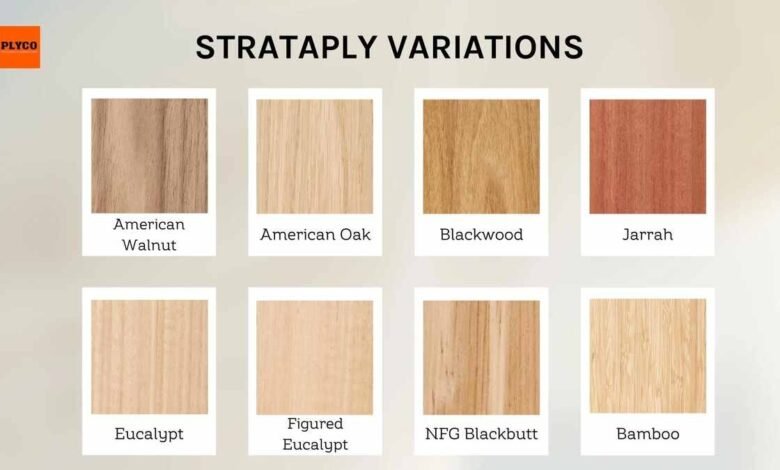
Plywood is a versatile building material that is used in a wide range of construction and DIY projects. Understanding the different types of plywood can help you choose the best option for your specific needs. Baut & Mur by hafas: Here’s a comprehensive guide to the 12 types of plywood, their characteristics, and best applications.
1. Softwood Plywood
Softwood plywood is made from softwood species like pine, fir, or spruce. It’s commonly used in construction for wall sheathing, roof decking, and sub-flooring. Key Benefits: Lightweight, easy to cut, and generally cost-effective.
2. Hardwood Plywood
Made from hardwood species such as oak, maple, or birch, hardwood plywood is known for its strength and resistance to wear. It is frequently utilized in the creation of furniture, cabinetry, and interior design. Key Benefits: Strong, durable, and has an attractive finish.
3. Tropical Plywood
Tropical plywood is made from mixed tropical wood species. It’s valued for its superior quality and strength compared to softwood plywood. Key Benefits: Excellent stability, high density, and durability.
4. Marine Plywood
Designed for moist and humid conditions, marine plywood is made with waterproof adhesive. It’s ideal for boat building and other applications exposed to water. Key Benefits: Water-resistant, high strength, and durable in wet conditions.
5. Aircraft Plywood
This is a high-strength plywood made from mahogany or birch. Used in aircraft construction, it’s incredibly durable and lightweight. Key Benefits: High strength-to-weight ratio, capable of withstanding heavy loads.
6. Exterior Plywood
Exterior plywood is bonded with water-resistant adhesive, making it suitable for outdoor use. Common applications include exterior walls and outdoor furniture. Key Benefits: Weather-resistant, robust, and long-lasting.
7. Lumber Core Plywood
Lumber core plywood has a core made from solid wood strips, with layers of wood veneer on both sides. This type is commonly used for high-end furniture and cabinetry. Key Benefits: Strong, stable, and less prone to warping.
8. Overlaid Plywood
Overlaid plywood is regular plywood coated with a layer of resin-impregnated fiber. It’s often used in concrete formwork and high-traffic surfaces. Key Benefits: Smooth, durable surface, resistant to chemicals and abrasion.
9. Structural Plywood
This type is specifically designed for structural applications such as beams, flooring, and load-bearing walls. Key Benefits: High strength, reliable load-bearing capacity, and meets building code requirements.
10. Flexible Plywood
Flexible plywood, also known as “bendy plywood,” can be bent and shaped into curved structures, making it useful in furniture design and architectural elements. Key Benefits: Highly flexible, easy to manipulate for creative designs.
11. Particle Board
Though not a traditional plywood, particle board is made from wood chips and resin. It’s used in low-cost furniture and as underlayment. **Key Benefits:** Economical, smooth finish, and easy to work with.
12. Fire-Retardant Plywood
This plywood is treated with fire-retardant chemicals, making it suitable for use in buildings where fire resistance is essential. **Key Benefits:** Enhances safety by reducing flame spread and smoke development.
Choosing the Right Plywood for Your Project
When selecting plywood, consider factors such as the environment (indoor vs. outdoor), the structural demands, and the aesthetic requirements of your project. Here are some tips to help you decide:
For Outdoor Projects: Go for marine or exterior plywood due to their water-resistant properties.
For Furniture: Hardwood and lumber core plywood are superb options due to their durability and appealing appearance.
For Construction: Structural and softwood plywood are commonly used for their durability and cost-effectiveness.
For Creative Designs: Flexible plywood is perfect for projects that require bending and shaping.
The Role of Fasteners in Plywood Projects
The choice of fasteners can significantly affect the performance and longevity of your plywood project. Here are a few tips: tokohasil.com
Use corrosion-resistant screws and nails for outdoor projects to prevent rusting.
Consider the thickness of the plywood when choosing the length of your fasteners to ensure a secure hold.
Pilot holes can help prevent splitting, especially in hardwood plywood.
By understanding the types of plywood and choosing the right one for your project, you can ensure that your build is both durable and aesthetically pleasing. Whether you’re constructing a piece of furniture or an entire building, the right plywood can make all the difference.

